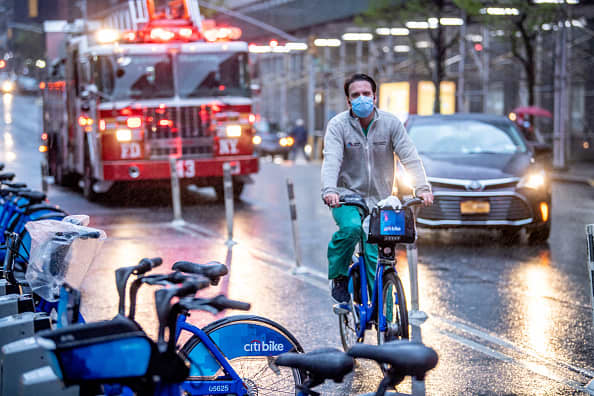
I was biking up a big hill in Boston on a recent Sunday morning, an activity I’ve resorted to now that I can’t play tennis or go to spinning class. I was huffing and puffing, so I pulled down my face mask, which is required outdoor attire in my town. I noticed a runner coming downhill on the other side of the wide four-lane street we were sharing. She lifted her hand and then pointed at me, screaming that I needed to pull my face mask up over my nose. Since we were about 50 feet apart, I would never have heard her if not for the decibel level.
So much for road-warrior camaraderie.
We are living in the era of coronavirus, as well as, Covid-shaming. This permeates not only the sidewalks and grocery stores, but also the media. Each interview of a shop owner in Georgia or state governor considering re-opening spurs multiple “Do you really think that’s safe?” questions.
Shame and fear effectively deters action that goes against the prevailing grain, but how does that relate to the stock market?
The S&P collapsed 35% from its peak on Feb. 19 until March 23, on recognition, mixed with understandable panic, that the coronavirus’ global spread would overturn every economy in the world, killing hundreds of thousands, if not millions, along the way. As a believer in equity markets, I wrote an op-ed in which I described the ways to measure the limits to market bottoms, including valuation and bailout programs, some of which seemed in place in late March.
In only five weeks, the S&P has climbed more than 30%, to just 15% below its all-time peak. The market has advanced so fast, during the plight of the pandemic, that it almost seems blasphemous to be bullish. If the moral position is to Covid-shame anyone whose mask is pulled down while biking uphill, how could anyone publicly embrace a rising S&P that ignores increasing deaths, particularly in the home state of Wall Street; unfathomable unemployment; massive business failures; a possible 40% to 50% drop in the nation’s gross domestic product this quarter; and huge federal deficits?
Nevertheless, the market shook off warnings of policymakers and pundits who are certain that reopening should be both glacial in timing and conditional on universal testing or an effective vaccine — which are both many months, if not years, away. Stocks have steadily scaled a wall of not just worry, but intense fear of insensitivity to the suffering around us. The implication is that investors believe that the wall was too high and the market was too pessimistic in late March.
The buyers have been challenging the analysis of every news network epidemiologist and hospital chief of staff as they bet that the worst is behind us. If it is sacrilegious to argue publicly that six weeks of social isolation, stuck in your house with the same few people, should dramatically lower the risk of getting or giving the infection, one alternative is to quietly place buy orders for equities. Likewise, trillions of funding for struggling businesses, consumers, and borrowers is enormously comforting.
Last weekend, Brett Stephens of the New York Times penned a piece with which I agree, sheepishly, of course, suggesting that the entire country should not be on the same re-opening schedule as its hardest-hit state, New York. Westchester County has 1.6 times the deaths as Texas, which has thirty times the population.
Others of us, who work in a profession often accused of heartlessness, may feel less empowered to be outspoken. It seems particularly callous to defend the market’s sharp upward slope as a reflection of curve flattening, while the numbers of people dying continues to rise.
If we examine the mortality data from my state of Massachusetts, we see that 86% were patients over age 70, 98% had underlying conditions, and only 1% were under the age of 50. None of this makes me feel good, but it suggests that focusing resources on the at-risk groups, rather than all populations equally, is logical. The stock market may have understood these numbers weeks ago.
A day of reckoning will arrive when results need to back up the market’s optimism. We may see corrections from the current level, but buyers are likely to continue to lodge their protest against pessimism about our post-crisis future by acquiring equities.



